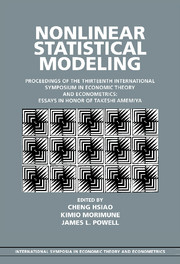 Nonlinear Statistical Modeling
Nonlinear Statistical Modeling Book contents
- Frontmatter
- Contents
- Series editor's introduction
- Editors' introduction
- Contributors
- 1 Local instrumental variables
- 2 Empirically relevant power comparisons for limited-dependent-variable models
- 3 Simulation estimation of polychotomous-choice sample selection models
- 4 A new approach to the attrition problem in longitudinal studies
- 5 Semiparametric estimation for left-censored duration models
- 6 Semiparametric estimation of censored selection models
- 7 Studentization in Edgeworth expansions for estimates of semiparametric index models
- 8 Nonparametric identification under response-based sampling
- 9 On selecting regression variables to maximize their significance
- 10 Using information on the moments of disturbances to increase the efficiency of estimation
- 11 Minimal conditions for weak convergence of the sample standardized spectral distribution function
- 12 Unit root tests for time series with a structural break when the break point is known
- 13 Power comparisons of the discontinuous trend unit root tests
- 14 On the simultaneous switching autoregressive model
- 15 Some econometrics of scarring
- 16 A censored switching regression approach to evaluating the effect of sunk costs and firm-level disequilibrium on export performance
- Curriculum vitae of Takeshi Amemiya
- Index
6 - Semiparametric estimation of censored selection models
Published online by Cambridge University Press: 05 June 2012
- Frontmatter
- Contents
- Series editor's introduction
- Editors' introduction
- Contributors
- 1 Local instrumental variables
- 2 Empirically relevant power comparisons for limited-dependent-variable models
- 3 Simulation estimation of polychotomous-choice sample selection models
- 4 A new approach to the attrition problem in longitudinal studies
- 5 Semiparametric estimation for left-censored duration models
- 6 Semiparametric estimation of censored selection models
- 7 Studentization in Edgeworth expansions for estimates of semiparametric index models
- 8 Nonparametric identification under response-based sampling
- 9 On selecting regression variables to maximize their significance
- 10 Using information on the moments of disturbances to increase the efficiency of estimation
- 11 Minimal conditions for weak convergence of the sample standardized spectral distribution function
- 12 Unit root tests for time series with a structural break when the break point is known
- 13 Power comparisons of the discontinuous trend unit root tests
- 14 On the simultaneous switching autoregressive model
- 15 Some econometrics of scarring
- 16 A censored switching regression approach to evaluating the effect of sunk costs and firm-level disequilibrium on export performance
- Curriculum vitae of Takeshi Amemiya
- Index
Summary
Introduction
The object of this chapter is the investigation of a particular approach to estimation of the parameters of bivariate (and multivariate) latent dependent variable models under weak assumptions on the distributions of the unobservable error terms. The class of latent variable models considered includes a number of microeconometric applications, including the censored sample selection models of Gronau (1973) and Heckman (1974), the disequilibrium regression model with observed regimes proposed by Fair and Jaffee (1972), and other simultaneous Tobit models. A survey of such models can be found in Chapter 10 of Amemiya (1985).
A common feature of these models is the noninvertibility of the transformation from the unobserved error terms to the observed dependent variables; since the error terms therefore cannot be written as a known function of observable random variables and the unknown parameters, zero mean and other moment restrictions on the errors are inadequate to identify the parameters of interest. Another feature common to these models, which distinguishes them from multinomial and other discrete response models, is the continuous distribution of the dependent variable in one (or more) equation of interest on some subset of its support. Unlike discrete response models, where some normalization of the parameter vector is typically required, the units of the regression coefficients relating the dependent variable to the regressors are well defined, and the scale of the parameter vector should (in principle) be identified.
- Type
- Chapter
- Information
- Nonlinear Statistical ModelingProceedings of the Thirteenth International Symposium in Economic Theory and Econometrics: Essays in Honor of Takeshi Amemiya, pp. 165 - 196Publisher: Cambridge University PressPrint publication year: 2001
- 13
- Cited by


